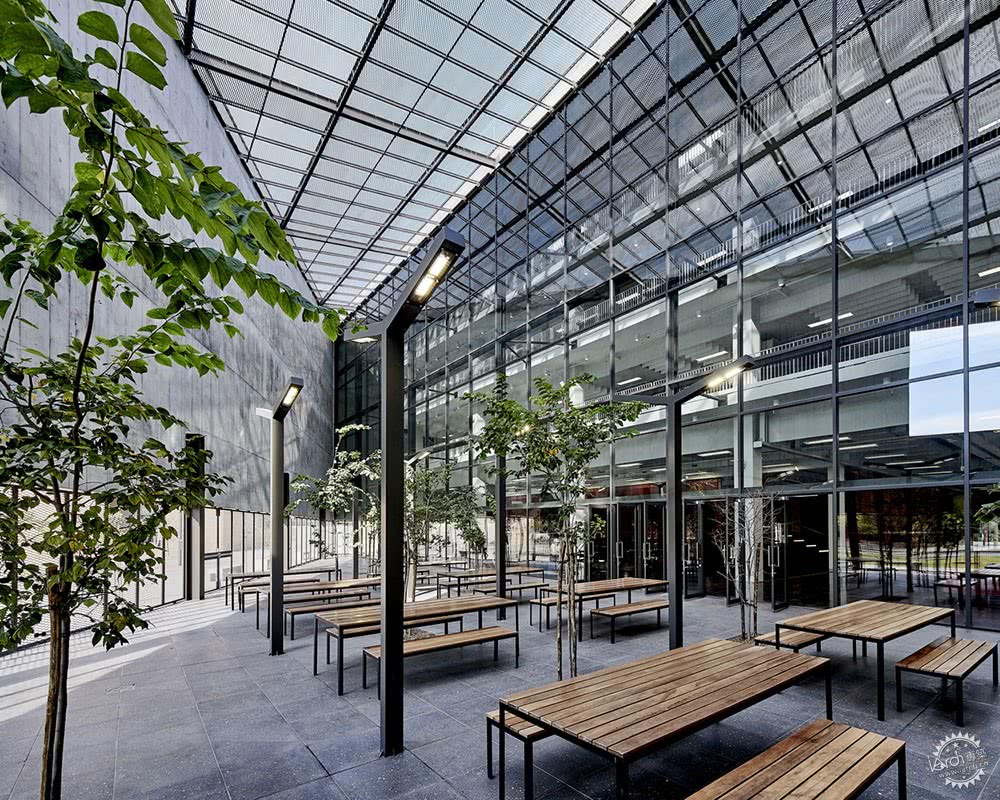Sol Plaatje大学生资源中心
Sol Plaatje University Student Resource Center / Designworkshop

来自建筑事务所的描述:2014年,Sol Plaatje大学(SPU)成为了南非民主时代的第一所全新大学。这里最初只有135名学生,而在后来的10年里,这个数字预计将增长至7500,这与Square Kilometre Array Telescope(SKA)的策略相类似。
Text description provided by the architects. In 2014, Sol Plaatje University [SPU] opened its doors as the first new University in South Africa’s democratic era. Strategically close to the Square Kilometre Array Telescope [SKA], its initial intake of 135 students is expected to grow to 7 500 within its first 10 years.

该项目位于Kimberley城市内,城市设计策略是将现有市民、公众、教育场所和全新的大学建筑相结合,这是城市内部的核心部分,同时也是高等教育场所。也许这也是人们的心之所向。
Located in Kimberley’s Inner City, a progressive Urban Design Framework seamlessly incorporates existing civic, public and education stock with new purpose-built University buildings, positioning tertiary education as an integrated part of Inner City life. Perhaps it’s heart.


Designworkshop事务所成功地在两个阶段的建筑竞赛中脱颖而出,其概念设计方案将学生资源中心概念化,并将其作为大学生活的功能与物理中心,其中包含有图书馆、教学区、学习区,以及社交空间。
Designworkshop was successful in a two-stage architectural competition towards conceptualising and delivering a Student Resource Centre as the functional and physical centrepiece of University life, including library, teaching, study, and social space.



问题的关键在于,南非有着全球一体化的发展概念,那么,哪种类型建筑能够将这种趋势最优化表达?
The key question we explored was what this emerging typology could optimally be and enable in the South African reality of a globally integrated world.

古代知识共享的形象是在公共空间中,人们聚集在老人、思想领袖和大师周围,这件事也许发生在河边,也许在树下,也可能在公共广场与街道,这就是社会环境中集体学习氛围的产生。而在社会之中这种氛围不易区分,学习可以通过实践和现实生活的感知而获取,这是一种经验化的过程,并且常常发生在传统文化领域。
Ancient images of knowledge-sharing are of people gathered around elders, thought- leaders and gurus, in Public Space. Depending on where and when, this could be by the side of a river, under a tree, in a public square or on a street-side. This is learning and knowledge generation in a social setting. Within society and indistinguishable from it, learning is enabled by the practical and perceived reality of life as it’s experienced, often on a platform of traditional cultural practice.


当信息以书面形式记录下来,学习的形象便又成为了一张书桌,这是积累知识的过程,并非来源于直接的经验,而是以一种更为直观的方式进行传播。即科学的中性特征。
When information was recorded in writing, the emblematic image of learning is often the quiet study table surrounded by books. This is the dissemination of accumulated knowledge, most commonly recorded outside of the direct experience and as a more linear and one-directional transmission abstract from specific cultural settings. The ‘neutrality’ of science.

SPU图书馆和资源中心则将这两个概念结合在一起。这是社交场所,人们会在日常生活中进行交流,这种沟通不仅仅可以面对面进行,还可以通过网络,无论有没有书本,有没有老师指导,这种方式都能够顺利地进行下去。
The SPU Library and Resource Center integrates both, at the same time. It’s a social place where people make themselves available to wide-ranging incidental and planned interchange in the course of daily life, both in physical space and online, with and without books, collectively and in solitude, directed and enabled by mentors or among themselves.
这个空间既是一棵树,也是河边,同时还是公共广场与街道。
建筑地面层以公共区域为核心,同时也是Kimberley城市道路、广场、花园的一部分。这个公共空间远离各种极段气候。
It is at the same time a tree, the side of a river, a public square, and a street.
Centred on a raked public forum, the ground floor is an extension of Kimberley’s pavements, paths, squares and gardens. It’s a public space sheltered from the cyclical hot and cold extremes of the arid climate.
每个楼层都属于公共广场,使用者可以从旁侧进入,无论公共还是私人,人们都可以在连续的知识空间里享受三维的探索。
Ascending from public to private, each additional floor is another ‘public square’ accessed from its perimeter to enable 3-dimensional exploration of a continuous knowledge-scape.
南非建筑的室内空间特征便是实心增强模具泥浆的应用。工人们将这种传统做法扩大至22厘米厚的单独混凝土薄壳,其高度为36米,形成了单个空心体量,人们在最高处能够俯瞰大学广场。
Solid grass-reinforced moulded mud forms typify South Africa’s interior vernacular brakdak construction. The Library scales this heritage up into a 22cm thick freestanding concrete shell rising up to 36m high and lifted off the ground to reveal a single hollowed-out volume ascending upward to its highest point overlooking University Square.
这座建筑就如同一座特别的雕塑体,就好像将Kimberley的标志Big Hole钻石反转而成,其来源于诸如koppie、brakdak住宅,亦或是矿井的水平形态。建筑主要应用了混凝土,这既起到了结构作用,同时也是建筑外立面,另外还能微调空间小气候,灵活应用在各式功能之中,表达了对于传统的崇高敬意。
The inverse of Kimberley’s iconic Big Hole diamond mine, the building is a distinctive sculptured object, arising from the endless horizontality like a koppie, brakdak house, or mine shaft. In a single material, concrete is structure, enclosure, climatic attenuator, flexible use-enabler, extended tradition, and noble experience.
在日常大学生活之中,建筑如同庇护所,并成为24小时的冬季休息区与夏季走廊。
In everyday university life, the building is a refuge, a 24 hour winter lounge and summer verandah.
在资源稀缺的社会之中,这种做法高效节能,同时能够在适当的自然光线中保持较低的热量损耗,而混凝土地板中设置有热水管与冷水管,用于室内的温度调节。
In a world of scarce resources, it is highly energy efficient, allowing in the right amount of natural light with significantly mitigated heat-gain or loss, the internal temperature further moderated by hot and cold water pipes embedded into concrete floors.
在城市里,这是民主学习、社会、文化交流的标志,同时也是经济潜力的发展产物,因为这种发展潜力常常来源于知识与思维。
In the City, it’s a landmark of democratic learning, social and cultural exchange, and a generator of economic potential which always comes from empowered knowledge and ideas.